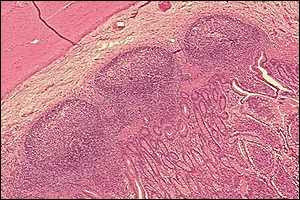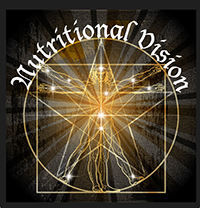Immune Mechanisms In Allergic Eye Diseases: What Is New?
By Katherine A. Carroll, NTP
Aside from dry eye syndrome, the most common complaint at the clinics is itching, burning, excessive tearing, grittiness, and irritation. This often makes comfortable contact lens wearing out of the question. It isn’t confined to any particular season either. Unfortunately many people think that medicines like Pataday will eliminate allergy symptoms for good and, like eliminating dry eye, it isn’t going to resolve with a topical medication. It takes working from the inside out.
The gastrointestinal tract and the liver are intricately related to eye health and vision. When people get jaundice, a liver ailment, it shows in yellow-tinged eyes. When people can’t stop rubbing their itching, watery eyes, it can often be traced back to a GI tract overrun with yeast, bad bacteria, and an imbalance of ‘friendly’ bowel bacteria.
A healthy digestive system is filled, from one end to the other, with nearly five pounds of good bacteria and microbes. We usually think of the GI tract in terms of digestion, but 60% of our immune system is found here in the form of Peyer’s Patches making this the logical place to start eliminating allergic eyes by strengthening the immune system.
Basically the GI tract is also a lymphoid organ with lymphoid follicles called Peyer’s Patches similar to lymph nodes. They are responsible for immune function at this level. “The lumen of the gastrointestinal tract is outside of the body and much of it is heavily populated with potentially pathogenic microorganisms. It is thus important that the immune system establishes and maintains a strong presence at this mucosal boundary, and indeed, the digestive tube is heavily laden with lymphocytes, macrophages and other cells that participate in immune responses.” Here’s a good explanatory link where the quote originated from: http://www.vivo.colostate.edu/hbooks/pathphys/digestion/basics/gi_immune.html

Peyer’s Patches
In order for this system to function at its peak it requires the proper balance of bacteria. We include not only probiotic capsules in our diet (taken on an empty stomach with cool water) but we also eat cultured fermented vegetables like sauerkraut, cultured almond-milk yogurt, kim chi, and drink kombucha, etc. Staying off sugar is wise. We also teach a 4-R program to restore the GI tract. Homeopathic solutions like Similacin work well as a topical agent.

Dispensary and Tech Office
Donna Gates wrote The Body Ecology Diet (http://bodyecology.com/)which gives a good understanding how to build healthy bowel flora in the GI tract. The Gaps Diet, Gut and Psychology Syndrome: Natural Treatment for Autism, Dyspraxia, A.D.D., Dyslexia, A.D.H.D., Depression, Schizophrenia by Natasha Cambell-McBride, is another.
We all know antibiotics kill good bowel bacteria, so many of us use garlic instead. But stress is often the overlooked culprit in reduction of good bacteria and generally damaging the GI tract. An October 2012 study show “rats subjected to heat stress damages intestinal mechanical and mucosal immune barriers, and reduces immune function of the intestinal mucosa and mesenteric lymphoid tissues, leading to bacterial translocation.” http://www.ncbi.nlm.nih.gov/pubmed/23094661.
The bottom line is that ocular and overall health is gained when we establish and maintain friendly bowel bacteria. Studies follow taken from PubMed:
 Medical Vision Center in Morton, WA- We were the first to add Nutritional Therapy
Medical Vision Center in Morton, WA- We were the first to add Nutritional Therapy
Improvements in seasonal allergic disease with Lactobacillus plantarum No. 14.
1We conducted two randomized, placebo-controlled, double-blind studies of Lactobacillus plantarum No. 14 (LP14) in female students with seasonal allergic diseases. We also examined the mitogenic activity and cytokine inducibility of LP14 using Peyer’s patch cells and mesenteric lymph node cells of swine. For subjects who took 8.7×10(8) of LP14, a significant improvement in ocular symptom-medication score was observed. In the placebo group, the T helper type 1 (Th1)/T helper type 2 (Th2) ratio tended to decrease after a 6-week intake period, while in the LP14 group, the percentage of Th1 cells significantly increased. Post-intake eosinophil counts significantly increased in comparison to those at intake cessation in the placebo group, but it appeared to be suppressed in the LP14 group. There were no changes in fecal microflora. LP14 strongly induced the gene expression of Th1-type cytokines. This study indicates the clinical effects of LP14 on seasonal allergic diseases.
Clinical efficacy of probiotic Bifidobacterium longum for the treatment of symptoms of Japanese cedar pollenallergy in subjects evaluated in an environmental exposure unit.
BACKGROUND:
Japanese cedar pollinosis (JCPsis) affects nearly one in six Japanese. Oral administration of Bifidobacterium longum BB536 has been shown to be effective in relieving JCPsis symptoms during the pollen season.
METHODS:
This double- two-way crossover study was designed to evaluate the efficacy of BB536 on reducing symptoms in JCPsis patients exposed to Japanese cedar pollen (JCP) in an environmental exposure unit (EEU) outside of the normal JCP season. After a 1-week run-in period, subjects (n=24) were randomly allocated to receive BB536 powder (approximately 5×1010) or placebo twice a day for 4 weeks. After a 2-week washout period, subjects were crossed over to another 4 weeks of intake. At the end of each intake period, subjects received controlled JCP exposure for 4 hours in the EEU. Symptoms were self-rated 30 minutes before and every 30 minutes during the exposures. From the first day of exposure through the next 5 successive days, participants self-rated their delayed symptoms and medication uses. Blood samples were taken before the exposures. The mean JCP levels for exposures were 6500 to 7000 grains/m3 air.
RESULTS:
In comparison with placebo, BB536 intake significantly reduced the ocular symptom scores during JCP exposures. Evaluating delayed symptoms after exposures indicated that scores for disruption of normal activities were significantly lower in the BB536 group compared with the placebo group. Prevalence of medication use was markedly reduced by BB536 intake.
CONCLUSIONS:
These results suggest the potential beneficial effect of BB536 in relieving symptoms of JCP allergy.
1http://www.ncbi.nlm.nih.gov/pubmed/20834165Biosci Biotechnol Biochem. 2010;74(9):1869-77. Epub 2010 Sep 7. Nagata Y, Yoshida M, Kitazawa H, Araki E, Gomyo T. Source, Momoya Co., Ltd., Saitama, Japan. y.nagata@momoya.co.j Abstract
2Allergol Int. 2007 Mar;56(1):67-75. Epub 2007 Jan 29. Xiao JZ, Kondo S, Yanagisawa N, Miyaji K, Enomoto K, Sakoda T, Iwatsuki K, Enomoto T. Source,Food Research and Development Laboratory, Morinaga Milk Industry Co., Ltd., Kanagawa,Japan,j_xiao@morinagamilk.co.jp Abstract
(c) 2012 Katherine A. Carroll All Rights Reserved

No Comments Yet